Abstract
To sustain the existence of the human race environment is a vital issue and hence awareness relating to environmental impacts of Low-Cost Carriers (LCCs) and Tourism is rising globally. It is proven that the so-called myth of degradation of environment finally is judged right and the raised the questions of environmental friendliness. This study has been designed to mark out how these environmental impacts have taken place and their consequences. Furthermore, the study provides the responsibilities that the LCCs should perform and the tourism industry is provided with options for the improvement of the global environment and the face of these industries. The green concern, eco-friendly business, is having the most awareness and creates opportunities for niche marketing and real-time marketing strategies.
Introduction
Rost, S., et al, (2006, pp. 6), stated that after the deregulation of the aviation market in 1990, the entrance of Low-cost carriers (LCCs) highly affected the charter airlines and scheduled airlines in the UK. The commencement of LCCs was directed to leisure tourism, but later these also targeted the business segment. They added that the LCCs are more threatening to scheduled airlines as the LCCs offer a higher frequency of daily flights to widely ranged destinations. Hence, scheduled airlines are losing a higher portion of their business travelers. As stated by BAA (2006), 90% of total flights of Stansted airports are made up by LCCs in the period and in 2004, 16 LCCs covered 159 destinations. The pricing strategies and cost-cutting approach of LCCs make these differences and more economically sustainable. The LCCs are a major contributing factor in the tourism sector of the UK but the problem is the large-scale operation’s impact on the environment, causing environmental degradation, through harmful emissions. As the LCCs (for example EasyJet, Ryanair, etc) are major in numbers of fleets and in-flight numbers in the aviation industry, therefore they are blamed to a great extent.
The success of Low-cost Carriers and the Industry Deregulation of 1980’s and 1990’s
The hit of deregulation of the airline industry of the late 1980’s makes the European Union’s airline market open for low cost-low frill airline services. The deregulation made in 1997 paved the way to benefit the passengers, largely the leisure travelers through charging the least costs ever. Cooper, C., et al., (2008) mentioned that before 1990’s the Airline was more enthusiastic to provide luxuries and many little extras to customers but later it was found that the customers were more enthusiastic to save money rather than have luxuries and these little extras. As the case, thereto the Airliners cut off many of these extras and gave the customer to enjoy saving money through low-cost carriers.
According to Rost, S., et al. (2006, pp. 6) before the deregulation the European aviation market was divided into two parts the scheduled carriers, targeting the business travelers, and the charter airlines, targeting leisure travelers. They also added that the commencement of the LCCs in the deregulated regime increased the competition for routes and passengers and thus price differentiation and competition among all the segments have resulted. Cooper, C., et al., (2008) stated that many of then Airliners anticipated the vast opportunities of the LCCs because of consumers’ demand for low-cost service and hence changed themselves to be adept for the competition. Such a move changed the differentiation between the major three competitors namely scheduled carriers, charter airlines, and Low-cost carriers.
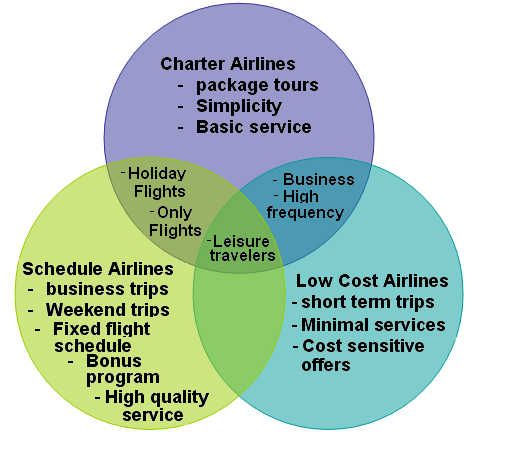
As the statement made by McIntosh R. W., (2000), market penetration of LCCs has been growing over the years and the expansion opportunities are also positive looking because the varied cultures of Europe and large population base is a huge market for interests. Furthermore, more leisure opportunities of the same make the people more prone to the leisure travel and hence low costs-low frills Airliners get more consumers who travel frequently. According to Rigas, D., (2001), the users of LCCs in 1994 were less than 3 million passengers in Europe, which is increased to 17.5 million in 1999 and to 85 million in 2003. Such phenomenal growth proved the sustainability of LCCs. Page, S., and Connell, J., (2006) argued that the volume of the same was 107 million, an increased volume of another 24%.
As stated by Rost, S., et al. (2006, pp. 6) the LCCs rely mostly on simplification and standardization of internal processes such as one-class operation, electronic ticketing, and less turnaround time to increase profit-making air time. Rigas, D., (2001), also suggested that all these attempts result in the reduction of operating costs of 40% to 65% per seat and on per kilometers flown (McKinsey & Company, 2002), and help to reduce ticket fare by 50% to 70% as compared to scheduled carriers. These entire phenomenons make the LCCs sustainable in the downturn of an economy too.
Rost, S., et al. (2006) also argued that one of the major reasons for the LCCs successes is the selection of the Airport. The LCCs usually choose an Airport, which usually charges low ground charges and so of other charges and therefore they chose secondary Airports, for example, Stansted airport. The market shares of these LCCs are also substantial.
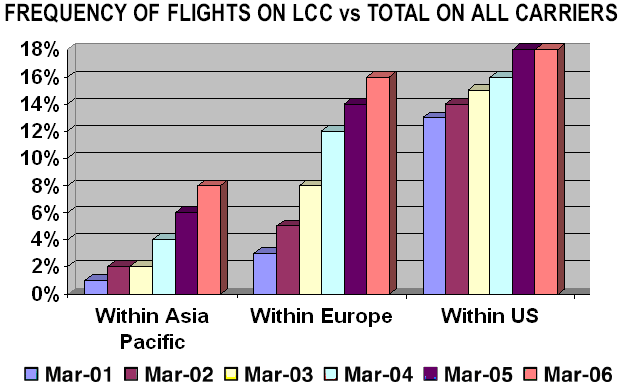
According to a report of OAG (2006) the market dynamics and trends of LCCs in 2006 contributing to its growth are:
- The most important success of LCCs especially in the EU is the taking travel in Air to the very reach of the customer;
- A force that moves LCCs along its success paths was the inclusion of more than 10 countries in the EU and therefore widening the market size;
- The most matured market of the EU is the United Kingdom (UK) from where most LCCs are usually operated;
- Into the market share of trip machinists, LCCs aimed the resorts and ingestion;
- The most growth areas are Central and Eastern Europe; and
- There are proofs that in the latest markets they can grab the market share of bequest carriers.
The debate of Environmental Impacts of Aviation, the Myth and the Reality, and LCCs Responsibilities
The global environment has been affected by greenhouse gases, as aviation is the main source of emanations, which pollutes the environment. The concentration of the greenhouse gases such as CO2, CH4 and NO is increasing that can change the UK’s climate as the atmosphere is received these noxious gases. Gill, M. and Humphreys, J., (2007, pp.7) argued that the aviation sector added 5.5% of CO2 of total CO2 emissions of the UK and total climate change due to the emission amounts at 11%. This trend of rising is ongoing because of the rising number of travelers and airlines. The Department of Transport of UK estimated such increment as following:
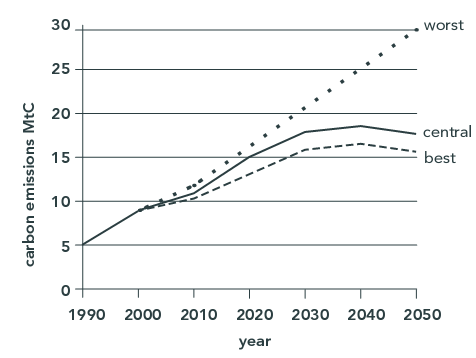
Here the worst scenario would occur because of the same operations as of the present time but the least emission in the central best scenarios would take place because of high efficient fuel use and innovation of better engines. However, people are more concerned about CO2 emissions but noise pollution is also a major environmental impact of aviation. Climate Action Network Europe, (2006), provided few environmental impacts from aviation have discussed as follows:
With a growing mode, aviation is presently causing 4 to 9% global climate change on the basis of people’s anti-environment activities and 5 to 12% in the EU. But it was thought that aviation is narrowly responsible for climate change as of 2 to 3%. The climate impact projection of 2030 stated 5% in the EU environment was wrong because of the mere growth projection of the aviation industry amounting to 1.6% per year. However, from 1990 to 2003, the actual data is that the industry has grown at a growth rate of 4.3% per year. Sausan, et al. (2005) stated that in 2004, EU25 CO2 emissions was stated as 3%, a real figure on a sector basis, but total climate impact was 2 to 5 times greater than that of state.
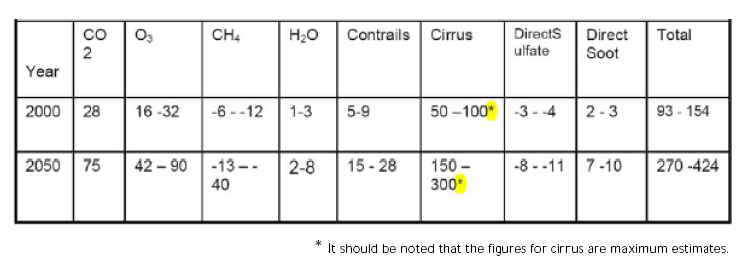
There is no change or some narrow changes in the efficiency of the planes rather these are as efficient as of 1950’s. However, it is thought the newly invented planes are highly fuel-efficient and such innovation is growing. T&E by the Dutch Aerospace Laboratory (NLR 2005) showed in research that over the last 50 years there is barely any sort of enhancement in the terms of fuel efficiency. Furthermore, the last piston-powered airliners of the early fifties were as much efficient as today’s turbojet (Climate Action Network Europe, 2006, p. 7).
The aviation is two to ten times more climate and environment concentrated than surface transport. But it is thought that cars are more climate intensive. According to the report of Climate Action Network Europe, 2006, the airliners’ performances in terms of climate impact are two to ten times inferior to the performance of the long-haul cars and long-haul Lorries. From the following figure, an assessment could be made that the most emissions contributions to our earth are made by the aviation industry both in the favorable scenario and in the least favorable courses.
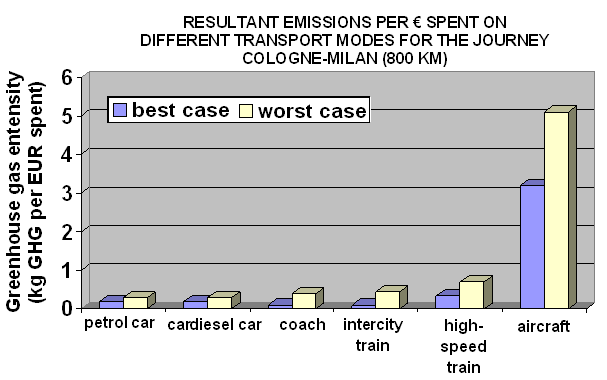
Once it was thought that the contribution of aviation to the World’s GDP is large. But the actual result is that 1% contribution to the world’s GDP and only 0.1% contribution to the global employment. The worse thing is that the contribution of the same to the human-induced climate change is 4 to 9%, which is almost the round way. Once it was also thought that the aviation industry covers all related costs through its payment. But it is found that the industry is mostly subsidized which gets the most tax exemptions from the Government and hence is getting benefits over others’ industries. These include subsidies and tax exemptions, duty-free sales, and VAT exemption.
All the above-stated facts are also true for the LCCs because European Low Fares Airline Association also rejected these notions made and accepted the myths stated above. On the other hand, the sustainability of the airliners they are paying environmental costs such as taxes and internalize costs to tackle climate change, noise and air quality. These are to be taken as responsibilities for the LCCs to lessen up the environmental and climate changes. By accomplishment of these responsibilities, it would enhance the growth of the tourism industry terming it as an eco-friendly business.
Recent Market Trends
The recent market trends of the aviation industry and tourism industry range from greening to efficient operations. Byron, B., (2008) stated that consist the commencement and development of internet-based operations, almost all classes of the society use air travel, advancement of technologies, an increase of awareness of environmental impacts of tourism and LCCs’ aviation, etc. Further stated that improvement of fuel efficiencies, increase in the performance of new and aging engines, new airframes and infrastructure development and improvement of traffic services through ‘green’ approaches. According to Pritchard, L., (2008), green travel trends scenarios amount to environment-friendly travel are highly liked by 50% or more travelers. Further stated that 13% of travelers even are willing to pay a higher rate for environment-friendly travel and 56% of travelers are willing to pay more. He also added that 09% of travelers are seeking green hotels and whereas 38% stayed in green hotels.
The most important trend from the above-stated trends is the rise of green awareness and environmental washing groups. These groups have substantial impacts on the said industries and for the very reason green travelers’ numbers and occupancy rises.
Possible Responses of Tourism Industry to the Air Transports’ Environmental Impact
According to the report of OECD (2001), tourism and its related aviation impacts on the environment and climate completely rely on destination choices and departures. Because these two issues are prime variables in the decision-making process of house-hold level tourism and travel. However, in compliance with the idea to limit choices to travel and departure is not a good idea because such a step would make the tourism industry a desert. Rather the report of OECD (2001), suggested the following ideas and strategies that the tourism industry can take into account:
- Information dissemination of the impacts caused by tourism-related travel on the environment and climate: the information about tourism and travel is usually reactive and/or proactive because travelers usually get and collect related information from different media. Therefore, there are opportunities for the dissemination of travel choices data set accordingly. Green marketing, the marketing strategy conscious about the environmental issues and its quality, is thus evolving in the course of time. Green marketing or eco-tourism is consciously checking the environmental aspects of tourism and such niche market is evolving very rapidly all over the world. Generally, the travelers are more enthusiastic to know about the place where they are leaning for but it does not mean they are not environmentally conscious. In many aspects, the travelers are implicitly aware of the fact. Hence, there is a strong requirement for taking a rapid and long-term intended information catering and dissemination system such that it could increase awareness about the environmental impacts of tourism and its travels. In the account providing the travel, opportunities’ information and giving green alternatives to the same would increase awareness and thus lessen the impacts on environment and climate.
- Creation and Promotion of Leisure Alternatives: the two variables that make people for going for travel are disposable income and leisure time. Hence, these factors should be expended other than long-haul travel. Tourism may create alternative time passing activities so that people would turn to these. Moreover, the industry could increase secondary homeownership because of such ownership people tended to less travel to other areas. The industry may establish several parks, lakes, etc. for recreational facilities to its market base.
- Creating and Promoting Tourism in Own Country: such an initiative would make people reluctant to go outside of the country. If it is taken into account and implemented, several benefits will arise such as a favorable balance of trade of the economy, less vulnerability in domestic tourism, and rural development. Moreover, a wide range of such alternatives would be cost-effective and because of using some other sorts of travels, it would lessen environmental degradation. Moreover, such a development will increase inbound travels and thus with more of profits the costs of environmental degradation will be minimized.
- Promoting Long Stays: rapid heading towards different kinds of recreational places increases air traffic and thus more environmental degradation. Moreover, if longer vacations are taken and travelers could be retained for a long time in the industry then it would lessen costs of fuel and costs of environmental impacts. Thus, the recourse would be lessening the frequency of simultaneous trip taking. This may also be included in the terms of employment. Amount of a number of flights of LCCs are much than that of luxury carriers so if not the travel frequencies decrease there will be more harmful to the earth to degrade it.
Conclusion
The Low Costs Carriers are the most invading industry in the recent global recessionary economy. In addition, the tourism industry is also one of the most revenue-earning businesses globally. These two correlated industries are also reasons for environmental and climate degradation individually and in collaboration. There are several attempts taken by the authorized bodies all around the world such EU, Australia, America, etc. The countries passed several policies and measures for the betterment of the environment. There are high concerns globally on global warming, climate change, sea-level rise, etc. And hence, the contributions of these two industries to those environmental impacts are under deep concentration. It has been proved that aviation particularly LCCs, having large-scale air fleets, frequency and occupancy rates, are more responsible for such environmental impacts. As the LCCs are more concentrated towards leisure travel, as of tourism, that is why the correlation of both the two was taken into account in the study. It is clear that the rapid technological advancement, compliance with regional and international environment-saving policies, use of bio-fuel (solely bio-fuel no need of extra kerosene), etc. could make the LCCs industry fur reaching. Unless if any contrary takes place then travelers awareness, the strong need for greening environment, and policies aforesaid would once forego LCCs. Therefore, in the scenario of threatening LCCs and the tourism industry, it is time to take prudent activities. The performance of the responsibilities directed that to LCCs and options to the tourism industry, such an environmental assault could be cut off to save the earth and the lives therein.
Bibliography
BAA, 2006, Low cost airlines.
British Airways, 2008, British Airways Annual report 2007-2008 Web.
Byron, B., 2008, An assessment of trends and risk factors in passenger air transport, Civil Aviation Authority of Australia, ISBN—978-1-921475-056-4.
Climate Action Network Europe, 2006, Clearing the Air: The Myth and Reality of Aviation and Climate Change.
Cooper, C., et al., 2008, Tourism: Principles and Practice, 4th edition, Pearson Education, ISBN: 978-0273684060
ETA, 2008, Air Travel’s Impact on Climate Change.
Easy jet Plc, 2008, Annual report of Easy jet Plc 2008.
Easy jet Plc, 2008, Financial Statement of Easy jet Plc 2008.
Francis, G., Dennis, N. Ison, S. and Humphreys, I. 2007, The transferability of the low-cost model to long-haul airline operations, Tourism Management, ISBN: 9780415445306 pp.391-398
Gill, M. and Humphreys, J., 2007, Aviation and Climate Change: Public Opinion and the Scope for Action.
Gössling, S., et al, 2007, Voluntary carbon offsetting schemes for aviation: efficiency, credibility and sustainable tourism, Journal of Sustainable Tourism.
Gössling, S. and Peeters, P., 2007, ‘It does not harm the environment!’ An analysis of industry discourses on tourism, air travel and the environment, Journal of Sustainable Tourism, 15 (4), pp. 402-417.
Holloway, J., 2006, The Business of Tourism, 7th edition, Financial Times/Prentice Hall, Harlow, ISBN: 9780273701613
Jet2.com, 2008, Low-Cost Airlines: A Brief History.
Lynes, J and Dredge, D., 2006, Going Green: Motivations for environmental commitment in the airline industry, A case study of Scandinavian Airlines, Journal of Sustainable Tourism, 14 (2), pp. 116-13
McIntosh R. W., 2000, Tourism: Principles, Practices and Philosophies, 5th edition, ISBN: 978-0471830382
Page, S., and Connell, J., 2006, Tourism: a modern synthesis, 2nd Edition, Thomson Learning, ISBN: 1-88480-198-5
Pritchard, L., 2008, American Green Travelers and Trends.
OAG, 2006, OAG report on European Low-cost carriers.
OECD, 2001, Household Tourism Travel: Trends, Environmental Impacts and Policy Responses.
Rigas, D., 2008, The airline business in the 21st century, 7th edition, Routledge London, ISBN: 9780838503317
Rost, S., Krüger, J., & Brande, K., 2006, Low-Cost Carriers and their Impact on European Tourism.
Ryanair Holdings, 2007, Annual report 2007 of Ryan air.
Ryanair Holdings, 2008, Annual report 2008 of Ryan air.
Wheeller, B., 1991, Tourism’s troubled times: Responsible tourism is not the answer. Tourism Management, Vol. 12, No. 2. pp.91-96